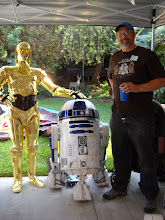I was anxious to get the leg pieces all glued up. Before I was committed to having them together, though, I wanted to do any work on the individual pieces that might save me headaches later. This means the little cut outs in the arm pits, right below the shoulders. There's just no easy way to do this, but cutting the inner piece of plywood before it was glued helped. Then I traced that outline onto the outer and inner pieces of plywood, and chiseled the material out to spec with my mortiser, and a some work with a sharp chisel and hammer. Some putty, sanding, trimming, and carving got the whole little pocket into pretty good shape before the glue up. Sorry no pictures of this part. Email me for more details.
A few tricks to share about the gluing process. First, when you glue pieces of wood together and clamp them under pressure, then tend to drift and slide around on each other, messing up your alignment of the edges. I glued two pieces at a time. While they were dry, I would clamp them together aligned exactly right. Then I would put a screw through the two pieces from the inside where it wouldn't show. Then I'd unclamp them, take out the screws, glue them, and put them back together. Then I"d put the screws back in carefully so that they went right back into the original holes. That way when I started clamping, the screws would keep the alignment perfect. If you've ever tried to desperately keep drifting pieces aligned while glue quickly dries, you'll see what a huge labor saver this is. In some cases where nothing could show, I would put a blind pin in between the two pieces by cutting the head off of a little finish nail, drill a little hole in one board, and then pressing other one onto it while keeping them aligned. This way there's no screw head showing. Sorry no pictures.
I think the tendency for a lot of people is to over clamp wood pieces. A couple of things. First, get an nice even thin coat of glue on both pieces to be glued. You want a small bead of glue to ooze out of the sides when they are clamped and drying. A lot of clamping pressure isn't needed. You'll drive all of the glue out of the joint and weaken the bond. Let the glue, not the clamps, do the work. Second, use some scrap pieces of wood under the clamp heads to prevent marring of your surfaces. If you do put a clamp dent in it, you can wet the dent thoroughly and then gently iron it with a hot iron. The water in the wood fibers will expand and the dent will swell back out. You'll be amazed at how big a repair you can do this way. Third, put the clamps on one at a time on opposite sides and slowly start to build up even pressure across the whole pieces. You can never have enough clamps. Get a bunch, and evenly distribute them around the edges. Put some newspaper underneath for the drips.
When the glue is about half way dry---about an hour for many wood glues and depending on the heat and conditions--you can gently scrape off the oozing drips on the edges with a chisel. It'll be clean and easy if you wait till then instead of doing it while the glue is runny. Sorry no pictures here either.











